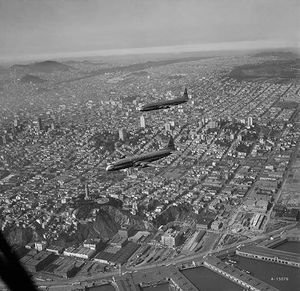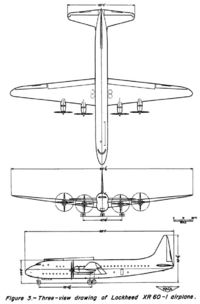PlaneSpottingWorld welcomes all new members! Please gives your ideas at the Terminal.
R6V Constitution
| R6V Constitution | |
|---|---|
| The XR6O/XR6V Lockheed Constitution landing at Moffett Field | |
| Type | Transport aircraft |
| Manufacturer | Lockheed |
| Maiden flight | November 9, Template:Avyear |
| Primary user | U.S. Navy |
| Number built | 2 |
The Lockheed R6V Constitution was a large, propeller-driven, double-decker transport aircraft developed in the 1940s by Lockheed as a long-range, high capacity transport and airliner for the U.S. Navy and Pan American Airways. (The Constitutions were identified as R6O until 1950.) Only two of the planes were ever built, both prototypes. Although these two planes went into service with the Navy, the Constitution design ultimately proved underpowered and too large for practical airline use at the time. The Constitution remains the largest fixed-wing aircraft type ever operated by the U.S. Navy.
Contents
Development
The Lockheed Constitution began life in 1942 as a joint study by the U.S. Navy, PanAm, and Lockheed. The design requirements, initially designated Lockheed Model 89, called for a large transport aircraft to improve upon the Navy's fleet of flying boats. PanAm was involved in the study because such an aircraft had potential use as a commercial airliner. This transport would carry 17,500 pounds of cargo 5,000 miles at a cruising altitude of 25,000 feet and a speed greater than 250 mph. The aircraft would be fully pressurized and large enough so that most major components could be accessed and possibly repaired in flight. For instance, tunnels led through the thick wings to all four engines.)
The aircraft was designed by a team of engineers led by Willis Hawkins and W.A. Pulver of Lockheed and Commander E. L. Simpson, Jr. of the Navy. The name Constitution was given to the project by Lockheed president Robert E. Gross.
The Constitution design had a "double bubble" fuselage, the cross section of which was a "figure eight". This unorthodox design utilized the structural advantages of a cylinder for cabin pressurization, without the wasted space that would result from a single large cylinder of the same volume.
The original contract from the Bureau of Aeronautics called for 50 Constitutions for a total price tag of $111,250,000. However, on VJ Day, the contract was scaled back to $27,000,000 for only two aircraft.
Ship No. 1
The first Constitution, BuNo 85163, was built in the summer of 1946 at the Lockheed plant in Burbank, California. Because of the aircraft's large size—the tail towered 50 feet—Lockheed had to build a special hangar for final assembly. The $1,250,000 hangar, Lockheed-California's Building 309, measured 408 feet long, 302 feet wide, and the equivalent of six stories tall. The footprint of the hangar covered four acres.
The R6O made its first flight on November 9, 1946. Joe Towle and Tony LeVier flew the plane on a leisurely course to Muroc Air Force Base. Once there, the plane underwent a carefully documented test program. At this time, electronic data recording technology was not well developed, so instrument readings were recorded by a movie camera pointed at the instrument panel.
The first Constitution made a nonstop flight from Moffett Field to NAS Patuxent River on July 25, 1948. The pilot for the flight was Commander William Collins (USN) and the copilot was Roy Wimmer, Lockheed engineering test pilot. Four days later, the ship was formally christened by Mrs. John L. Sullivan, wife of the Secretary of the Navy, at Washington National Airport.
The R6O tested JATO takeoffs with six rockets mounted on the rear of the fuselage. At full gross weight, the rockets shortened the takeoff run by 24%.
Ship No. 1 was delivered to Navy Transport Squadron VR-44, based at NAS Alameda, on February 2, 1949. Both it and its sister ship, Ship No. 2 (which followed six months later), flew the route between California and Hawaii.
Ship No. 2

The second Constitution, BuNo 85164, first flew on June 9, 1948. This aircraft, like its predecessor, had a double-deck configuration. The second aircraft, however, had an upper deck fully furnished as a luxury passenger transport, with accommodations for 92 passengers and 12 crew. (Accommodations on the upper deck of the first Constitution were decidedly more spartan.) The upholstery on the upper deck was light gray with Navy blue trim. On the back of the forward bulkhead, in front of the spiral staircase leading to the lower deck, a permanent display case was occupied by a scale model of the original USS Constitution sailing ship.
The lower deck had 7373 cubic feet of cargo space, and it was loaded by an electrical hoist. The lower deck could also be converted to seat an additional 76 passengers.
The second Constitution, like its predecessor, also made a nonstop transcontinental flight. On February 3, 1949, the aircraft flew its 16 crew and 74 members of the press from Moffett Field to Washington National Airport. At the time, this was the largest number of people flown across the United States in a single flight. This flight inaugurated six months of regular service between Washington, D.C. and San Francisco.
In the early 1950s, Ship No. 2 made a Navy recruiting tour of 19 cities. The side of the fuselage proudly advertised "YOUR NAVY—AIR AND SEA." Some 546,000 toured the plane's interior.
Operational history
The Constitution had operational difficulties which prevented it from meeting its original design objectives. The four Pratt & Whitney R-4360s did not offer the power needed by such a large aircraft. The engine also had cooling problems, which was corrected by flying with engine cooling gills partially open. This added drag and decreased overall range.
The Navy operated the two Constitution prototypes through the end of the 1940s and into the 1950s. By 1949, however, the Navy announced that it could no longer afford to operate these planes, and offered them to airlines on a five-year lease. No airlines expressed interest in using the Constitutions, so the Navy retired both aircraft in 1953. They went into storage at Litchfield Park, Arizona in 1955.
The first Constitution was brought to Las Vegas, where it served as an enormous billboard for Alamo Gasoline[1], before getting scrapped. The second Constitution was flown to Opa-Locka, Florida, where it was stored before finally getting scrapped in 1978.
Specifications (R6V BuNo 85164)
General characteristics
- Crew: 12
- Capacity: 168 passengers
- Length: 156 ft 1 in (47.6 m)
- Wingspan: 189 ft 1 in (57.6 m)
- Height: 50 ft 4.5 in (15.4 m)
- Wing area: 3,610 ft² (335.4 m²)
- Empty weight: 113,780 lb (51,610 kg)
- Loaded weight: 160,000 lb (72,600 kg)
- Max takeoff weight: 184,000 lb (83,460 kg)
- Powerplant: 4× Pratt & Whitney R-4360 radial engine, 3,000 hp (2,240 kW) each
Performance
- Maximum speed: 303 mph at 25,000 ft (490 km/h at 7,600 m)
- Cruise speed: 260 mph (418 km/h)
- Range: 5,390 mi (8,670 km)
- Service ceiling: 28,600 ft (8,700 m)
- Rate of climb: 700 ft/min (210 m/min)
See also
Comparable aircraft
Related lists
Lists relating to aviation | |
|---|---|
| General | Timeline of aviation · Aircraft · Aircraft manufacturers · Aircraft engines · Aircraft engine manufacturers · Airports · Airlines |
| Military | Air forces · Aircraft weapons · Missiles · Unmanned aerial vehicles (UAVs) · Experimental aircraft |
| Notable incidents and accidents | Military aviation · Airliners · General aviation · Famous aviation-related deaths |
| Records | Flight airspeed record · Flight distance record · Flight altitude record · Flight endurance record · Most produced aircraft |
References
- ↑ Boyne, Walter J., Beyond the Horizons: The Lockheed Story. St. Martin's Press: New York, 1998.
- ↑ Yenne, Bill, Lockheed. Crescent Books, 1987, p. 58.
- Francillon, René J, Lockheed Aircraft since 1913. Naval Institute Press: Annapolis, 1987.
- McLarren, Robert. "Design Analysis: Lockheed Constitution Transport." Aviation Week, August 30, 1948, pp. 20-27.
- Society of Automotive Engineers. "Lockheed Constitution Development Story." SAE Preprint #556. December, 1950.
External links
- Article on the R6V Constitution from the Goleta Air and Space Museum website
- Lockheed R6V Constitution Article from General Aviation News
- Historic Lockheed photographs, including the R6V Constitution
Airliners and Civil Transports: Vega · Electra · Electra Junior · Super Electra · Lodestar · Constellation · Saturn · L-188 Electra · L-402 · JetStar · L-1011 TriStar
Military Transports : C-64 · C-121 · R6V · C-130 Hercules · C-141 Starlifter · C-5 Galaxy
Fighters: F-22 Raptor · F-35 Lightning II · F-94 Starfire · F-104 Starfighter · F-117 Nighthawk · P-38 Lightning · P-80 Shooting Star · T-33 Shooting Star
Patrol and reconnaissance : Hudson · PV-1 Ventura · PV-2 Harpoon · P-2 Neptune · P-3 Orion · CP-140 Aurora/CP-140A Arcturus · U-2 · SR-71 Blackbird · S-3 Viking
Giant aircraft | |
|---|---|
| Production | |
| Prototypes | |
| Concepts | Proposed: Airbus A380-900 · Reaction Engines A2 · Beriev Be-2500 · Boeing 747-8 · Abandoned: Boeing New Large Airplane · Boeing Pelican · McDonnell Douglas MD-12 |
| Wingless aircraft | Biggest airship: Luftschiffbau Zeppelin Hindenburg class · Biggest blimp: Goodyear ZPG-3W · Biggest helicopter: Mil Mi-12 |
Lists relating to aviation | |
|---|---|
| General | Timeline of aviation · Aircraft · Aircraft manufacturers · Aircraft engines · Aircraft engine manufacturers · Airports · Airlines |
| Military | Air forces · Aircraft weapons · Missiles · Unmanned aerial vehicles (UAVs) · Experimental aircraft |
| Notable incidents and accidents | Military aviation · Airliners · General aviation · Famous aviation-related deaths |
| Records | Flight airspeed record · Flight distance record · Flight altitude record · Flight endurance record · Most produced aircraft |
pt:Lockheed R6V de:Lockheed Constitution
{From Wikipedia}}

